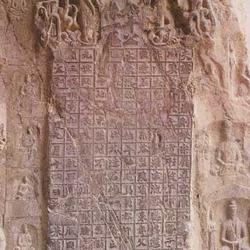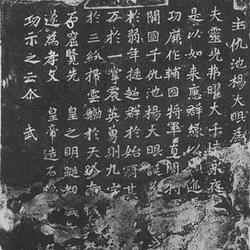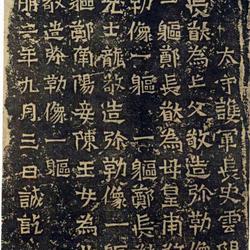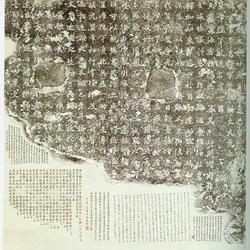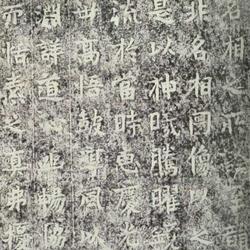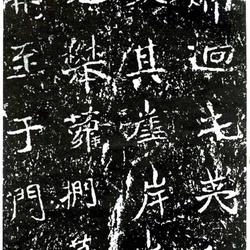The "Stele of Qing Ode to Zhang Menglong" was erected in the third year of Zhengguang reign of Emperor Ming Xiao of the Northern Wei Dynasty (May 22). Its full name is "The Stele of Qing Ode to Zhang Fujun, the Governor of Weilu County". It is now in the Confucius Temple in Qufu, Shandong Province. Zhang Menglong's achievements in establishing the school are inscribed on the stele. The ancients commented that his book "Zhengfa Qiu has opened the door to Europe and Yu", and he was praised by the world as "the number one stele in Wei". There are twenty-six lines in regular script and forty-six characters in each line. It is one of the masterpieces of the late Wei stele. The calligraphy of the stele uses a combination of square and round pens, and the knots are rectangular. Although the strokes are horizontal and vertical, they are varied, natural and beautiful. The four words "warm in winter and clear in summer" in the inscription are considered to be an important basis for identifying the ancient, current, original and revised extensions of Zhang Menglong's stele. It is said that some ancient people would remove a certain word or leave some mark on the original stele after each rubbing, so that the rubbings of future generations would never be the same or comparable to those of their predecessors, let alone forged. Yes, we can see the good intentions of the ancients.
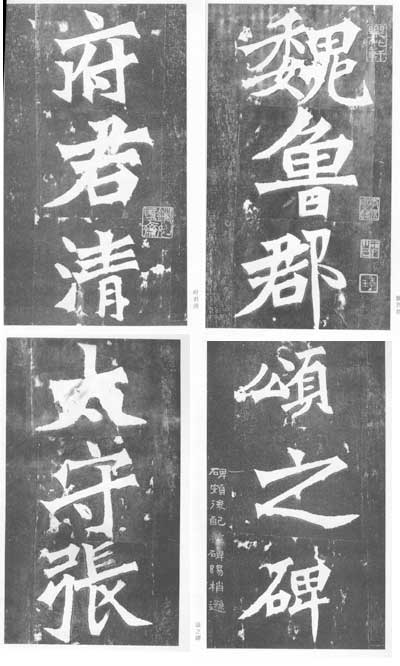
"Zhang Menglong Stele" is a brilliant pearl among the art treasures of Wei Stele calligraphy in my country. It has been radiating a strange brilliance for thousands of years! It has been highly praised since its creation. Yang Shoujing said in "Pingbeiji": "Easy and ancient, strange and upright are in harmony, which is why the Six Dynasties were higher than the Tang Dynasty people." Kang Youwei praised in "Guangyi Zhou Shuangji": "The structure is exquisite and the changes are unprovoked." "It is the sect of perversion of the orthodox body"! And it is listed as a "top quality".
This stele can be called the crystal of the Wei stele. The writing is calm and refreshing, like cutting gold and jade, clean and neat; the palace in the structure is tight and stretched out on all sides, and it is shaped according to the words, not rigid and square, achieving a natural and vivid effect. , and eventually became famous in the world for its diverse and steep structures. Since the Qing Dynasty, anyone who studies Northern Wei calligraphy has regarded it as a model!
Today, we will analyze some of the characters on the stele (Zhang Menglong Stele) and talk about the author's views on its "danger". This stele is a typical example of "slanted drawings and tight knots", and most of the characters are tilted to the side, which can be roughly divided into There are four types: left side, right side, left side and right side, and upper side and bottom side. They are very dynamic and show their extraordinary magnanimity.
1. Zuo Jian - the danger of Qijin
There are two forms of Zuoji: either the whole body is tilted to the left and the vertical stroke is tilted (such as "style", etc.), or the parts are offset, up, left, lower and right to make a left-leaning posture (such as "square", "dang", etc.).
The oblique hook of the word "Shi" is tilted as much as possible, the horizontal paintings are short and slanted, and the vertical paintings also have a left-hand posture and a flying posture; the first point of the character "Fang" is like a rock, the horizontal paintings are flat and stretched, and the "knife" part is to the right When writing, a single hook is used to support it, and the whole thing is tilted but does not fall down.
The character "Dang" starts off to the left, off-center, and the horizontal hook is oddly slanted. It seems that the trend of corruption is unstoppable. However, the calligrapher cleverly combined the left and right sides of "mouth" and "field" to create a "mainstay" that supports the overall situation. However, the most important thing is that "Tian" Yu was written in a broad and profound way, which finally stabilized the left-leaning situation, turned danger into safety, and made people breathe a sigh of relief!
2. The right side - the danger of Qizong
The right side of the monument occupies a certain proportion of the monument. Either the vertical painting tilts to the right, or the painting stretches to the left, and the whole word tilts to the right (such as "ruo", "house", etc.), or it goes up, right, down, and left. The right tilt is caused by moving the up and down positions (such as "Qi", "Qing", etc.).
The character "Wu" is left-handed and stretched out, which makes it dangerous because there is no support to rely on. However, the "Zhi" part is aligned with the top, and the final stroke is steady, making the whole character tilt but not falling over, and seeking stability in the momentum.
As for the word "Qi", the horizontal direction is not flat, and the vertical direction is not straight. The short horizontal direction is shorter, and the long horizontal direction is especially long. The upper part is tightly slanted, just like a leaning tower falling on the right half of the long horizontal direction. It is tilted and difficult to support! However, the writer However, a long point is left to the left to support the crisis, and the final stroke is heavy, "turning the tide"! This makes the whole word have a vivid feeling of dancing and ready to come out.
3. Left and right - the danger of a strange rise
The left part of the character "Xiao" tilts to the right, and the right part tilts to the left, forming the shape of upper part and lower part; the left part of the character "Although" tilts to the left, and the right part of the word "Xiao" tilts to the right, forming the shape of upper part and lower part; Mount Tai stands erect, "even though" it looks like a falling star, but it all seems to be tilted and upright, with a stable center of gravity.
The character "Huai" is straight and tall on the left side, and converges on the upper right side. Suddenly, the "four" part is written extremely slanted and extremely low, and the danger suddenly emerges. What's even more amazing is that the lower part is already cramped, but the horizontal strokes and strokes are bold and calm, forcing the vertical lift to meet the right side. What a danger! The reader has changed the last two strokes freely and freely, and clicked out lightly. The whole word corresponds to the left and right sides, which is transcendent and steady, and it is amazing!
4. The upper side and the lower side - the danger of extraordinary escape
It is not an exaggeration to say that every word in "Zhang Menglong Monument" is strange and every word is the same. If you carefully appreciate the shape of the inscriptions below, it is not difficult to appreciate the unique ingenuity of the writer:
The character "Yin" leans to the right at the top and to the left at the bottom, achieving tranquility in movement; the character "Ning" leans to the left at the top and bottom, while the middle part leans to the right, which has been changed in the whole. What’s particularly astonishing is: Changheng swings to the left as much as he can, creating a dangerous situation, and finally uses the vertical hook to shift the center of gravity back to the right, stabilizing the dangerous situation in an instant, which makes people applaud!
In addition, words such as "zi, endowment, and camp" are all on the upper side and lower side, and they are as dangerous as walking on the ground. They are strange but not strange! "Changes are contained in the neatness, and strangeness is hidden in the square. They are all wonderful." The calligraphy In kung fu, Si is the first. It can be said that man is extremely ingenious but nature's workmanship is wrong!" (The words are from "Guang Yi Zhou Shuang Ji·Bei Wei Tenth") The word "嬹 Side" can be seen everywhere in "Zhang Menglong Monument", which is eye-catching. It can be reached, and its steep changes are often unexpected, giving you the feeling of "a dragon sees its head but not its tail". Therefore, when practicing, you must not just know the shape and blindly write the characters in an oblique manner, which will become rigid and rigid. You must carefully figure out the characteristics of the brushstrokes and word formation of this stele, look at the strokes through the edge of the knife, and focus on understanding why. Some words are very slanted but the center of gravity is stable, and some strokes are very slanted but visually give people a sense of majesty. Gradually, they understand the wonderful way of turning danger into safety, and strive to use pen and ink to express the unique shape and charm of the stele. The above is just a simple analysis of (Zhang Menglong Monument) from the perspective of "oblique" and "dangerous", which is inevitably shallow and biased. If it can give you some inspiration and reference in the process of learning Yibei, that would be the author's pleasure!
The emperor's taboo is "raptor", with the word "jiong" (神冏). A native of Baishui, Nanyang. His clan was divided. From the source. Therefore, detailed world records have been prepared. No longer contained. ? ?
? ? Sheng. Weng means Yu at the beginning of the emperor's reign. Dexing? ? . The image of yao is among the red birds. Among the deep and mysterious mountains and valleys. Climb (chan) above the thousand peaks of rock. Yi (yi) Ye Qinggao. Huan (huan) is as good as the article (du). Zhou Xuanshi. ? ? Zhang Zhong. The poet praises his filial friends. Guang Ji Ji (ji)? . ZTE is a failure. Mr. Zhang (?), a doctor of Jin Dynasty. In the Spring and Autumn Period, his achievements are celebrated. In the early Han Dynasty, King Jing of Zhao Zhang Er. Ups and downs between Qin and Han Dynasties. Finally, the reward for crossing the ranks of scholars. Talented people. You will come after you. Wei Mingdi Junior High School. Xizhonglang will make Chijie Pingxi General Liangzhou Governor Shi Huan (huan, Huan?) the tenth generation grandson. Eighth generation ancestral track. Emperor Yongxingzhong. He sent General Chijie Anxi to protect Qiang Colonel Liangzhou Governor Xiping Gong. The seventh generation ancestor. The third son of Rail. Emperor Ming of Jin Dynasty was in Taining. Linqiang (qiang) Duwei Pingxi General Xihai Jinchang Jincheng Wuwei four counties prefect. Suijia Wuwei. Gaozu Zhongxin. When King Wuxuan of Liangzhou greatly suppressed the canal. General Jianwei and Governor Wuwei. Great Ancestor Chapter. Liang is a weightlifting scholar. In the governance of this prefecture, he served as the prefect of the two counties of Hailedu in Shixi. He also went to the Shangshu Temple (ci), Lang Yulin Supervisor. The ancestors prospered the clan. The Puppet Liang (liang) capital camp guarded the army and established the festival general Rao (rao) River and the Yellow River County prefect . Father is happy. ? ? ? ? ? ? ? ? ? ? ? ? Return home. Qingjin (jin, meaning the same as Jin)'s ambition. The white head is strong. The king's body is endowed with river spirit. Shen Ziyue is (very?) beautiful. Guizhi Lanyi. A little bit of weakness brings out the beauty. Relaxed? Festival. ? ? ? ? ? ? . ? ? ? become. since? ? It's as bright as the new spring. The first lotus comes out of the water. Entering the filial piety and leaving the rank. Banglu (lv) is famous. Although the gold did not respond. No shame in Guo family. Friend? ? . Friendship? ? ? ? ? Super remote. Meng Zhengren watch. Year twenty-seven. Worried by my father. Eat and sleep with courtesy. Weeping blood and deep love. Suppose Zeng Chai is reincarnated. Ning different from today's virtue. It's both dry and overturned. Only rely on (shi) kun (kun) kindness. Warm in winter and clear in summer. Xiaoxi agrees. Poor family leads to support. Diligence without hesitation (same as "diligence"). Year thirty-nine. Ding's mother is in trouble. The spoon (shao) cannot be drunk. Seven Dynasties of Soul Stealing. Qing (qing) is about life and death. When you take off your clothes, you should be declared a nun without any shame. Deeply sigh that everything is extraordinary. Lonely and alone. The reputation is renewed day by day. The sound is purple. Born in Yanchang. Except for court invitations. You travel to the province of culture. Friends (chai) admire his elegance. The imperial court is looking forward to this. Virtue? Xuanchang. In the year of Xiping (Xi). In addition to the prefect of Lu County. Governing the people with courtesy. Move the wind to enjoy. Like the pain of injury, there is no slack (dai). In Suxiao. Like the love of a child. Have it in mind. Is it to make the school clear out the house and encourage the farmers to teach? Weave to log into Xuan (jing, realm?) to watch the dynasty. Don't be disrespectful. change? Unintentionally . The grass and rocks are changing. Grace and spring water. The birds and fish will be safe. Victory and disability do not wait for (she) years of credit. It's just a matter of months. Then he ordered the lecture to be given . Call again in the palace. The Song of Lysu. Repeatedly chanted in Zhu (killed?). Jing Zhao Wu Shou. There is no way to add. Henan Eryin. The decision can be made by Ruozi. Although the name and position are not the same. wind? ? . And change the custom? . Huang Hou is not worthy of comparison. The feeling of eating fish. Mizuning is uniquely known as virtue. Even quitting gold and jade, he was loyal and honest. Dial the sunflower to weave the faith. I am the king of Fang. It's still the same today as it was in ancient times. Poetry cloud. Kai (kai) Ti (ti) gentleman. The parents of the people. I'm really afraid that the Shao (shao) Xi (xi) will move. The east wind blows again. All the people in the land. Ni Shenxuan (xuan) admired it and published it in stone. It is beautiful with jing. Sincerity? Neng style. Chan (chan) Hong? . Shu Yang Lie? . His words said. Shi Huan (huan) astronomy. The body is inherited from Emperor Yin. Shenxiu Chunfang. The spiritual source is shaking. Chihiro Chihiro. The long pine trees with ten thousand swords crowned Zhou and Han Dynasties. The crown covers the Wei and Jin Dynasties. He Ling Yue Xiu. The moon rises and the scenery flies. The God of poverty shines. Style birth emblem. The mountains stand tall. Good things come true. The only virtue is dance. Only benevolence is the basis. Qi (qi) went to court late. As pure as snow. The sound of the crane is hard to stay. The sound is clear and clear. Tianxin is Juan. Sightseeing jade palace (que ). Huan (huan) Fu (fu) purple? . Chenghua Yanyue. Miao Jianwei? . Cut off the character of Confucianism. Fen Jinyi (yi) Road. Split Jin Zou Fang. Chunming is easy to raise. Warm? Frost. Such a person. The good of the country. present? ? ? . ? ? ? . ? ? The shirt (xu). Small and big, affection. ? ? ? wash. Zhuo (zhuo) this group is dark. The clouds ( qian) are pure. Enlightenment from thousands of miles away. Learn to build and practice etiquette. The wind teaches anyway. Let the fields be cultivated. can be changed. Keep me enlightened. Why don't you cut off your kindness? Why (fu) 昘(Is xi the same as happiness? Can't find it in the dictionary) weathering and moving new. Drinking from the river will stop it from being full. The sea is lost in the sea. Leshitu? . forever? ? . Dang bandit general Lu Juncheng Beiping? ? . The righteous leader participated in the military and Guangping Song Fu (fu) people. The hero of Xiang (xiang) Prefecture's cavalry joined the army. The chief of Xiangwei Prefecture, Shizheng, led the army to govern the city of Lu Prefecture? military? . The righteous person in charge of the second political affairs of this county? ? ? . Yizhu Yan Lu. The righteous lord Lihu ordered Song Chengbing. Fenyang County's loyalist leader Nancheng ordered Yan Xiaowu. Righteous Lord? Xianwen. Wang Pensheng, the chief registrar of Yi Zhu Prefecture in Yangping County. It took four years to create the song. It ended on the twenty-third day of the first month of the third year of Zhengguang (qi, remember?).
Reminder:
Qing Dynasty Bao Shichen: The official book "Zhang Menglong" fully succeeded the Great Order, and "Longzang Temple" fully succeeded the Youjun. ("Art Boat Shuangji")
Yang Shoujing of the Qing Dynasty: The calligraphy is elegant and ancient, and the strange and upright complement each other. This is why the Six Dynasties are superior to those of the Tang Dynasty. ("Ping Stele Record")
Kang Youwei of the Qing Dynasty: Later generations said that the most prosperous stele was none other than the Tang Dynasty, where famous masters were outstanding and all styles stood side by side. However, from my own perspective, it is not like that of the Wei Dynasty. The people of the Tang Dynasty paid most attention to structure, but the method of telescopicity back and forth. Among the monuments of the Tang Dynasty, which one can compare with "Yang Hui", "Jia Sibo", and "Zhang Menglong"! The style of his writing is rich and vigorous, and his moods are jumpy. The lengths and sizes vary according to their style. The white lines are drawn in stages and batches, which is wonderful. The changes are contained in the neatness , and the wonders are hidden in the square, all of which are extremely brilliant. He is the first in calligraphy skills. It can be said that man is extremely clever but nature's workmanship is wrong. ("Guangyi Zhou Shuangji")
Kang Youwei of the Qing Dynasty: "Zhang Menglong" is the sect of orthodox metamorphosis. Just like Zhou Gong's system of etiquette, everything is beautiful and good. ("Guangyi Zhou Shuangji")
Kang Youwei of the Qing Dynasty: The structure of "Zhang Menglong Stele" is the best of calligraphers, with short and long lengths and pitches, each according to its own style. I took "Zhang Menglong" from the main book, and each one has its own changes. ("Guangyi Zhou Shuangji")

